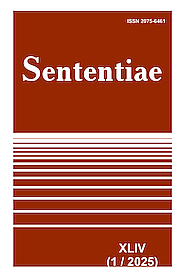„Learn from artists“ – Friedrich Nietzsche on the Art of Living
DOI:
https://doi.org/10.31649/sent44.01.019Keywords:
actor, illusion, perspectivism, transformation, cognitionAbstract
This paper examines the relationship between art and life in the works of Friedrich Nietzsche. While Nietzscheʼs topos of the “art of living” has often been explored as an ethos of self-formation, the specific connection with various arts is often overlooked. Both the actor and the painter become role models whose techniques are suggested as useful strategies. Scholars often overlook that Nietzsche corrects his earlier metaphysical ideas according to which art has the role of justifying life and, on the contrary, places art in the middle of life and no longer beyond it. While usually the actor is seen as hypocritic figure, Nietzsche not only develops a specific evolutionary-biological genealogy of the artist, outlining the artistʼs origin in the need for dissimulation and acting, but also emphasizes the power of metamorphosis and transformation. Finally, Nietzsche assigns to art a new significance, which is more than just creating works of art. Inspired by the techniques of art and artists, people can use its power to beautify, elevate and reinterpret their life. The philosopher himself benefits from the techniques of transformation, insofar as perspectival cognition becomes his guide.
References
Ashbaugh, K. (2008). Art for the Bodyʼs Sake: Nietzscheʼs Physical Aetheticism. In K. Comfort (Ed.), Art and Life in Aestheticism. De-Humanizing and Re-Humanizing Art, the Artist, and the Artistic Receptor (pp. 109-121). Basingstoke: Palgrave Macmillan.
Brock, E. (2014). Vom Schönmachen aller Dinge. Nietzsches Kunst der Transfiguration als antinihilistische Lebenskunst. Nietzscheforschung, 21, 197-207. https://doi.org/10.1515/nifo-2014-0116
Brock, E., Gödde, G., & Zirfas, J. (Hrsg.). (2022). Das Leuchten der Morgenröthe. Friedrich Nietzsche und die Kunst zu leben. Stuttgart: Metzler. https://doi.org/10.1007/978-3-662-65194-0
Came, D. (2014). Nietzsche on Art and Life. Oxford: Oxford UP. https://doi.org/10.1093/acprof:oso/9780199545964.001.0001
Gödde, G., Loukidelis, N., & Zirfas, J. (Hrsg.). (2016). Nietzsche und die Lebenskunst. Stuttgart: Metzler. https://doi.org/10.1007/978-3-476-05397-8
Hödl, H. G. (2005). Interesseloses Wohlgefallen. Nietzsches Kritik an Kants Ästhetik als Kritik an Schopenhauers Soteriologie. In B. Himmelmann (Hrsg.), Kant und Nietzsche im Widerstreit (S. 186-195). Berlin & New York: de Gruyter.
Kant, I. (1993). Kritik der Urteilskraft. (K. Vogtländer, Hrsg). Hamburg: Meiner.
Nietzsche, F. (1967-1977). Sämtliche Werke. Kritische Studienausgabe. München, Berlin & New York: Deutscher Taschenbuch Verlag & de Gruyter.
Nietzsche, F. (1996). Human, All Too Human. (R. J. Hollingdale, Trans.). Cambridge: Cambridge UP. https://doi.org/10.1017/CBO9780511812057
Nietzsche, F. (1999). The Birth of Tragedy. And other Writings. (R. Speirs, Trans.). Cambridge: Cambridge UP.
Nietzsche, F. (2001). The Gay Science. (J. Nauckhoff, Trans.). Cambridge: Cambridge UP.
Nietzsche, F. (2002). Beyond Good and Evil. (J. Norman, Trans.). Cambridge: Cambridge UP.
Nietzsche, F. (2005). The Anti-Christ, Ecce Homo, Twilight of the Idols, and Other Writings. (J. Norman, Trans.). Cambridge: Cambridge UP.
Nietzsche, F. (2007). On the Genealogy of Morality. (C. Diethe, Trans.). Cambridge: Cambridge UP.
Pieniążek, P. (2003). Geschichte, Kultur und Lebenskunst in „Menschliches, Allzumenschliches“. Nietzscheforschung, 10, 139-148. https://doi.org/10.1515/nifo-2003-0111
Pieper, A. (2022). Das Dritte Auge. Nietzsches Plädoyer für die ästhetische Wahrnehmung. In E. Brock, G. Gödde & J. Zirfas (Eds.), Das Leuchten der Morgenröthe. Friedrich Nietzsche und die Kunst zu leben (S. 43-53). Stuttgart: Metzler. https://doi.org/10.1007/978-3-662-65194-0_5
Ridley, A. (2007). Routlede Philosophy Guidebook to Nietzsche on Art. London & New York: Routledge. https://doi.org/10.4324/9780203964859
Schmid, W. (1992). Uns selbst gestalten. Zur Philosophie der Lebenskunst bei Nietzsche. Nietzsche-Studien, 21, 50-62. https://doi.org/10.1515/9783110244403.50
Schubert, C. (2018). Erkenntnispraxis als Experiment. Nietzsches Figurenreden und die „Kunst der Transfiguration“. Nietzscheforschung, 25, 313-324. https://doi.org/10.1515/nifo-2018-0025
Zwierlein, E. (2020). Auf dem Rücken des Tigers. Nietzsches dionysische Lebens-Kunst. Berlin & Münster: LIT.
Downloads
-
PDF
Downloads: 183
Published
How to Cite
Issue
Section
License

This work is licensed under a Creative Commons Attribution 4.0 International License.
- Authors who publish with this journal agree to the following terms:
- Authors retain copyright and grant the journal right of first publication.
- Authors are able to enter into separate, additional contractual arrangements for the non-exclusive distribution of the journal's published version of the work (e.g., post it to an institutional repository or publish it in a book), with an acknowledgment of its initial publication in this journal.
- Authors are permitted and encouraged to post their work online (e.g., in institutional repositories or on their website) prior to and during the submission process, as it can lead to productive exchanges, as well as earlier and greater citation of published work.









.jpg)
.png)



